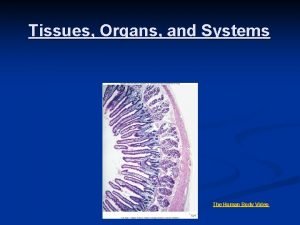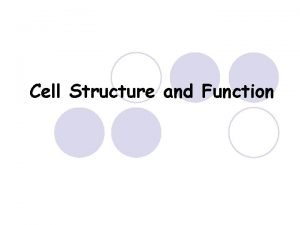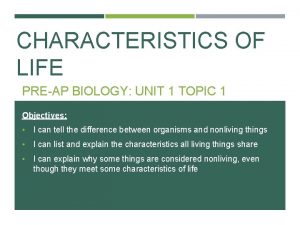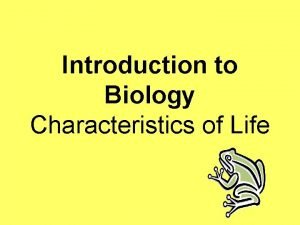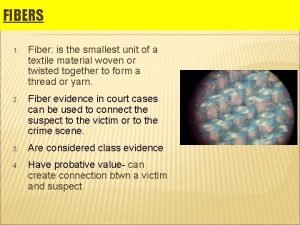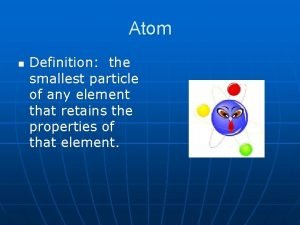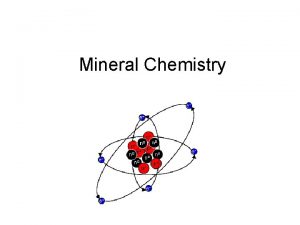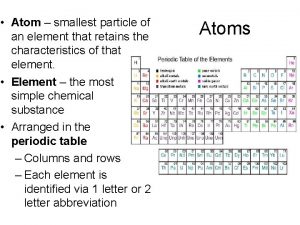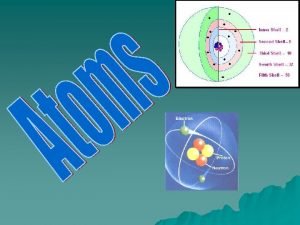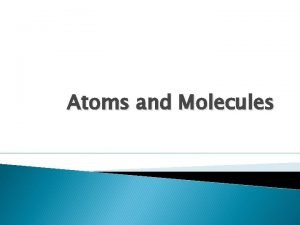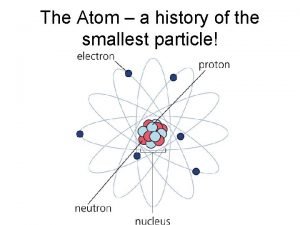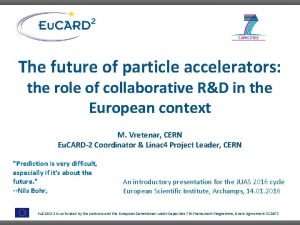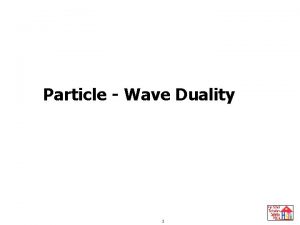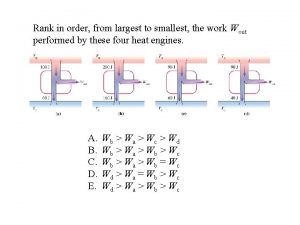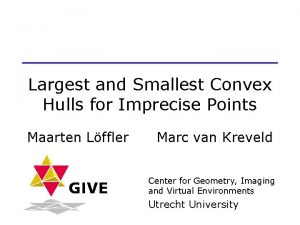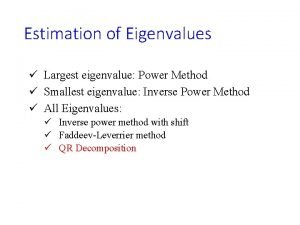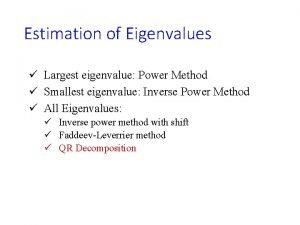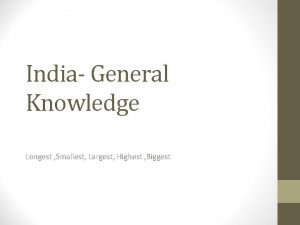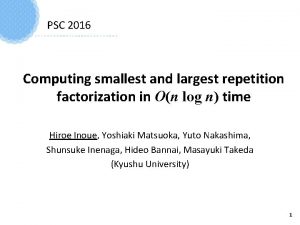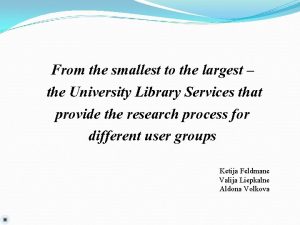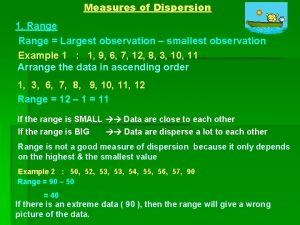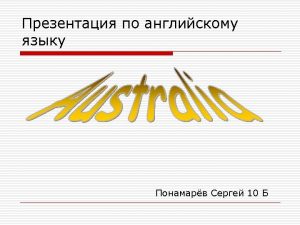Future Particle PhysicsCan We Understand the Smallest Largest
















































- Slides: 48

Future Particle Physics—Can We Understand the Smallest & Largest Phenomena Even Better? Or, why Einstein would today be a string phenomenologist Or, what Einstein would have liked to know Gordon Kane Michigan Center for Theoretical Physics Theme Semester

The goal of particle physics is to understand the physical universe as well as possible How well might we hope to do? Overview

“Understand”? o At least -- what are things made of, the basic particles? -- how do the particles interact to form the world? -- what are the rules that govern what happens? F=Ma o And maybe also – WHY is our world the way it is? -- are these features inevitable? THE ANSWERS TO THE FIRST QUESTIONS ARE KNOWN! -- THE STANDARD MODEL OF PARTICLE PHYSICS NOW MUCH PARTICLE PHYSICS RESEARCH IS ON THE SECOND QUESTIONS

• We also have a good description of the universe now and back to its beginning – short period of rapid expansion (“inflation”) – energy released in form of hot particles (“Big Bang”) – expanding universe – made of matter but not antimatter – today about 4% our matter, 25% dark matter, 70% dark energy – Standard Model of Cosmology (Katie Freese) • Huge progress in understanding condensed matter, complex systems around us (Len Sander) • Huge progress in understanding theory of quantum world – phase of “quantum control” has begun (Chris Monroe”) CAN WE EXTEND THE STANDARD MODEL(S) OF PARTICLE PHYSICS AND COSMOLOGY TO A DEEPER LEVEL – BEYOND DESCRIPTION?

NOW RULES ARE RELATIVISTIC QUANTUM FIELD THEORY • Basically formulated by Dirac by 1930 – understanding hugely improved and improving • Quantum theory ~ 1926 • Einstein’s special relativity 1905 HERE TO STAY

STANDARD MODEL OF PARTICLE PHYSICS Strong, Electromagnetic, Weak interactions o All we see is made up of electrons (e), up quarks (u), down quarks (d)! [quarks are particles like electrons, but with different electric charge and mass, and having an additional, strong, interaction] o Quarks interact via gluons, bind to make protons (p), neutrons (n) – leakage of the strong force outside p, n binds p, n to form nuclei [gluons are particles like photons, but in addition having the strong interaction] o Electrons bind to nuclei via photons to make atoms – leakage of the electromagnetic force outside atoms binds atoms to form molecules o Not just metaphors, full quantitative theory o Essentially all e, u, d were produced in the Big Bang

• Protons not in fundamental theory • Existence of protons, neutrons, pions and all properties (spin, electric charge, magnetic moment, mass etc) required by theory – today mass calculated to about 15%

THERE ARE MORE PARTICLES Ø MATTER: -- charged “leptons” µ, τ – like e but heavier -- quarks s, c, b, t – like u, d but heavier -- neutrinos (ν) – one each for e, µ, τ – extremely light, no charge Form 3 “families” u, d, νe, e s, c, νµ, µ b, t, ντ, τ NO IDEA WHY – all but e, u, d short-lived or do not bind – SM accommodates them and describes their behavior fully Ø HIGGS BOSONS – quanta of Higgs field that must be added to SM to accommodate mass – very good indirect evidence Ø DARK MATTER – not part of SM

• Always before found smaller constituents • No more – we think these are the true constituents • Why? o Suggested by experiment – have looked 100, 000 times deeper than naïve expectation if there were structure o For bound states, like atoms or the periodic table, usually many such states, no end – here strong evidence just 3 families o Have for first time a consistent theory that treats e, q as basic – theory describes and relates many phenomena so if change it whole structure collapses o If e, q basic can unify description of forces Description of e, q may change – e. g. may think of them as strings instead of point particles, but still electrons and quarks

HUGE PROGRESS IN UNDERSTANDING FORCES o In SM, existence of particles implies forces electron photon with correct interactions we understand light o All forces have same form o Forces seem to have different strengths – can ask how they behave if extrapolate them to high energies (short distances) – strengths get similar in SM (become same in supersymmetric Standard Model) electrical magnetic weak strong electromagnetic electroweak “grand unified”? gravity string theory?

• Coulomb ~ 1800 speculated on gravity and electromagnetic force having same form • Oersted, 1815 – “Magnetism, light, and heat are the effects of the same force…” • By ~ 1915 knew there must be 4 forces – Gravity – Electromagnetism – Radioactive decay of nuclei weak force – Stable nucleus containing protons strong force EINSTEIN – 1922 first paper on unification of forces -- 1953 last -- only tried to unify EM+gravity, classically

• Enrico Fermi’s phenomenological theory of weak interactions – 1931 – partly in same form as electromagnetism, with interaction of currents • Hideki Yukawa’s phenomenological theory of strong interactions, mediated by pions – 1935

HIGGS PHYSICS – last piece of SM • Accommodating parity violation in the Standard Model implies electrons and quarks are massless • Because electrons and quarks inhabit an internal “electroweak” space – in that space, left-handed (L) electrons and quarks behave as if they had “EWspin” ½, and right-handed (R) ones as if they had “EWspin” 0 • Not explained in SM, that’s just how it is (this is one of the things we would like to explain) • Then if e, q have mass, can go to their rest frame, rotate ordinary spin so L ↔ R, but then they have the wrong EW spin, so inconsistent – only two ways out o e, q massless o Add Higgs field with EWspin ½, and claim that energy of universe is lower when that higgs field has non-zero value than when zero – allows RH electron to behave as if had EWspin ½

• Technically the Higgs physics add-on to the SM works fine • If Higgs field exists, then quanta of field must exist, Higgs bosons • Good indirect evidence they do exist – from LEP electron -positron collider at CERN, 1991 -2001 – measured accurately about 20 quantities that should be described by the SM – all SM parameters known except Higgs boson mass – so do fit to all data with one parameter – get good fit if upper limit on mh below about 200 Ge. V (about twice Z boson mass)


STANDARD MODEL OF COSMOLOGY • The universe is tiny, contains some (unstable) energy density, and 3 space dimensions inflate • After very short time energy density converts into “radiation”, i. e. particles Big Bang • Universe cools and expands – today ~ 4% neutrons and protons (ordinary matter), ~ 25% dark matter, ~ 70% dark energy • Description works from world around us to the edge of the observable universe, back to about 10 -35 sec after universe began

From Sean Carroll

A century ago it was not agreed that atoms exist, and we had essentially no knowledge of weak and strong forces, nor did we know the universe and the earth had histories • The Standard Model(s) of particle physics and cosmology are wonderful, amazing – based on many remarkable experiments, and powerful innovative theory – achieves the goals of physics historically, in a full theory • Describe and explain many phenomena from a few basic particles, forces, and rules – no contradictions in their domain – SM consistent relativistic quantum field theory • Many predictions correct, tests • So why are we confident they will be extended? Most generally, the SMs do not seem compelling, inevitable

THERE IS MUCH THE STANDARD MODEL(S) CANNOT EXPLAIN o o o Neither cosmology nor the SM can tell us what the dark matter is Neither cosmology nor the SM can explain the matter asymmetry Neither cosmology nor the SM can tell us what the dark energy is Neither cosmology nor the SM can tell us the physical nature of the inflaton field The SM cannot tell us why there are 3 families of leptons and quarks The SM cannot give us insight into how to unify gravity and the other forces The SM cannot explain the origin of the Higgs physics The SM cannot allow calculation of the electron or muon or quark masses The SM cannot describe neutrino masses without adding a new mass scale The SM has a quantum hierarchy problem, very serious The SM cannot explain parity violation

Remarkably, in past 2 -3 decades, have learned that if we hope to understand these things the direction we need to go is to embed our 4 D world in additional space-time dimensions Two approaches show great promise for explaining what cosmology and the Standard Model(s) cannot: q Supersymmetry – for every space-time dimension add a quantum dimension q String theory – add 6(7) space dimensions like ours, except that ours inflated, others didn’t [some variations possible] – only known way to have consistent quantum theory of gravity – all 10 D have a quantum dimension too

• Extra D approach initiated by Kaluza, 1918 • Einstein was referee – remained interested in approach throughout his efforts • Major step taken by Oskar Klein, 1925, while he was an assistant professor here

Imagine small particle – go around several times, returning wave function to initial place n even → boson n odd → fermion [bosons are particles with integer spin, fermions with half integer] This is tied to being in 3 D – imagine a “superspace” dimension for each of our space-time dimensions Then can go into extra dimension and untwist fermion to get boson (or vice versa) ↔ ↔ So every fermion gets a superpartner boson, and vice versa

Suggests the idea of supersymmetry (~1973): THE LAWS OF NATURE DON’T CHANGE IF B ↔ F IN THE EQUATIONS DESCRIBING THE LAWS Originally very surprising – matter particles (e, u, d…) were fermions, force particles (γ, g, W, Z) were bosons – in quantum theory they were treated very differently – the idea was studied just to see if it could work Only idea in history of science that emerged purely from theoretical study rather than from trying to understand data, puzzles, observations – studied because it was a beautiful idea TURNED OUT IT COULD EXPLAIN MAJOR PROBLEMS

(SOME OF) WHAT SUPERSYMMETRY MIGHT DO FOR UNDERSTANDING THE NATURAL WORLD: o 1979 Stabilize the quantum hierarchy (like antiparticles for quantum electrodynamics) o 1982 Explain Higgs physics o 1983 Explain why the forces look different to us in strength and properties, but become the same at high energies o 1983 Provide a dark matter candidate (the lightest superpartner) o 1991 Allow an explanation of the matter asymmetry of the universe o 1992 Explain why all current data is consistent with the Standard Model(s) even though we expect new physics ALL SIMULTANEOUSLY

In addition there are theoretical motivations: • If supersymmetry is a local symmetry it implies General Relativity – if Einstein had not invented General Relativity it would have been (i. e. it was) written in 1975 by studying supersymmetry • String theory probably requires supersymmetry if it is relevant to understanding nature

IF SUPERSYMMETRY RELEVANT, SUPERPARTNERS MUST BE DISCOVERED AT COLLIDERS, SUCH AS TEVATRON, LHC Selectron photino gluino stop squark sneutrino etc They can be heavier than their SM partners


What is string theory? • A quantum theory that addresses the basic questions of particle physics and cosmology including gravity • Particles in field theory are point-like – in string theory they are tiny “strings”, i. e. they are described by equations that could describe a string • Only consistent in 10 D – 6 more space dimensions originally like ours, but now much smaller • One force in 10 D, four forces and particles in 4 D • An electron is still an electron, but thought of as a string rather than a point • In recent years a subfield “string phenomenology” has emerged – several international conferences and workshops – focuses on the mysteries the SM cannot explain and related issues

SOME QUESTIONS √ addressed √√ answered What is matter? What is light? What interactions give our world? Gravity Stabilize quantum hierarchy? Explain hierarchy? Unify force strengths? Higgs physics? What is dark matter? Baryon asymmetry? More than one family? 3? Values of quark, lepton masses? Origin of CP violation? What is the inflaton? Dark energy? What is an electron? Electric charge? Space-time? Why quantum theory? Origin of universe? Standard Model(s) Supersymmetric SM(s), light superpartners √ √√ √ String Pheno √ √ √√ √ √ √ √

There alternative approaches to some questions, but none that address all or even most questions

WHAT DATA COULD SOON GUARANTEE THERE IS NEW PHYSICS AT EXPERIMENTAL SCALES FOR PARTICLE PHYSICS? • Direct observation of superpartners at Tevatron, LHC • • o o Laboratory dark matter detectors Electric dipole moments of e, n (Muon anomalous magnetic moment) Lepton flavor violation (µ→eγ…) Bs→µµ at Tevatron or LHC ACP(B→φK) ≠ sin(2β) at b factories Understanding the background for the HEAT e+ excess

LHC (7 x. Tevatron energy) • January - March 2007, cool down • April 07, commissioning • June – October 07, two beams, collisions, expected luminosity ~ 5 x 1032 cm-2 sec-1 • November 07 – June 08, physics run (number of events = cross section x total luminosity) YEAR Total luminosity/detector (fb -1) 2007 0. 02 2008 1. 2 2009 4 2010 40 (currently the Tevatron has about 1 fb-1 per detector – could barely be sensitive to Higgs boson and superpartners)


Now a number of perspectives and concluding remarks

EFFECTIVE THEORIES – Why physics is the easiest science • • Don’t have to consider all of nature at once Usefully organized by the size studied by an approach universe galaxies solar systems, planets ☺ ☺ life, consciousness, etc ☺ condensed matter atoms nuclei Proton is output of SM, input to nuclear physics, astrophysics proton, neutron quarks, leptons Standard Model supersymmetric SM ANY THEORY WITH INPUTS string theory IS AN EFFECTIVE THEORY

EFFECTIVE THEORIES – Why physics is the easiest science • • Don’t have to consider all of nature at once Usefully organized by the size studied by an approach universe galaxies solar systems, planets ☺ ☺ life, consciousness, etc ☺ condensed matter atoms nuclei Proton is output of SM, input to nuclear physics, astrophysics proton, neutron quarks, leptons Standard Model supersymmetric SM ANY THEORY WITH INPUTS string theory IS AN EFFECTIVE THEORY

Mass now a research problem – probably all mass is due to interactions – at least 3 sources of mass • Almost all the mass of protons, neutrons is from the kinetic energy of quarks and gluons bound together (wouldn’t matter much if quarks massless) • Mass of quarks and charged leptons is related to Higgs physics but not only Higgs physics, e. g. me=Ye x (value of Higgs field) • Mass of dark matter particles (say LSP) due mainly to breaking of supersymmetry, some due to Higgs physics • Neutrino masses may be due to additional interactions • Mass can be accommodated but not explained in SM, and in supersymmetric SM • String theory can provide fundamental theory of masses, but not yet calculable – “Yukawa couplings” (Ye) cannot come from SM or SSM but can come from string theory

How do we think about the status of explanations, research? • • • Certainly Probably Maybe Issue is addressed Speculative research begun No clue Standard Model is not wrong, it will be extended – in fact, we think the Standard Model of particle physics is an exact symmetry of the most basic laws of nature

IS STRING THEORY TESTABLE? SURE, BUT NOT MUCH YET o Very big test if it can incorporate all of SM particles and forces, and address all questions consistently o In physics, “theory” means know the “Lagrangian” – but that’s not enough for predictions, since we live in the ground state of the system – must be able to calculate the potentials for all the fields, and go to their minima o What should be calculable as we learn to do this? -- inflaton might be one of the stringy fields -- string theory should tell us how supersymmetry is broken masses, cross sections of superpartners at LHC predict how much of dark matter is LSP -- should tell us number of families of q, l and allow us to calculate their masses, and explain why neutrino masses small – number of families related to number of dimensions -- cosmic strings, primordial magnetic fields “Toy” calculations underway, “string phenomenology”

Comments: If string theory isn’t right it will be wrong for the right reasons Could give up explaining some things – but in supersymmetric string theory all questions addressed, so no need to give up yet As we learn more are there more or fewer questions? Also, fewer inputs that don’t come from an effective theory.

Why do supersymmetry, string theory provide explanations? • Relativity + non-relativisitc quantum theory antiparticles + explained spin (and QED renormalizable) • Fermions + bosons superpartners + (possible) explanations • Gravity + relativistic quantum theory extra dimensions + (possible) explanations

Einstein: “A theory is the more impressive the greater the simplicity of its premises is, the more different kinds of things it relates, and the more extended its applications” “It would be sad if God didn’t use such a beautiful theory in the actual world…”

• A remarkable time for particle physics • Perhaps all the fundamental questions are formulated – never before! (defendable viewpoint) • Parameters of universe known to observable edge, back to beginning, to the smallest scales – never before (defendable viewpoint) • Quarks, leptons basic constituents • Perhaps we know what needs explaining • And there is a possible framework: 10 D string theory ↔ 4 D supersymmetric field theory of quarks and leptons GETTING DATA IS EXPENSIVE AND REQUIRES LEADERSHIP -- WITH LIMITED DATA CAN WE LEARN WHAT IS NEEDED TO TEST AND UNDERSTAND THEORY?

SOME QUESTIONS √ addressed √√ answered What is matter? What is light? What interactions give our world? Gravity Stabilize quantum hierarchy? Explain hierarchy? Unify force strengths? Higgs physics? What is dark matter? Baryon asymmetry? More than one family? 3? Values of quark, lepton masses? Origin of CP violation? What is the inflaton? Dark energy? What is an electron? Electric charge? Space-time? Why quantum theory? Origin of universe? Standard Model(s) Supersymmetric SM(s), light superpartners √ √√ √ String Pheno √ √ √√ √ √ √ √

“metric” a rule for calculating distance Einstein General Relativity: Suppose space-time 5 D Gravity in 5 D looks like 4 D gravity plus electromagnetic field! -- in 3 D gravity pulls in 3 directions – in 4 D, 4 directions – 3 of them our 3 D gravity, 4 th looks different if 4 th D small, looks like another force, just like EM -- to accommodate EM and weak and strong forced, 10 D needed

What if nothing is discovered at LHC?

What if nothing is discovered at LHC? NOT POSSIBLE

WHAT IF ONLY A LIGHT HIGGS IS FOUND AT LHC? • Assume detectors work well, analysis under control, etc • Indirect arguments strongly suggest some superpartners should be produced at LHC • If eventually none found, probably supersymmetry not relevant to understanding nature • But still likely some new phenomena at this scale, from same arguments
 To understand recursion you must understand recursion
To understand recursion you must understand recursion Smallest to largest level of organization
Smallest to largest level of organization Units of length smallest to largest
Units of length smallest to largest Producers
Producers Rough er function
Rough er function K strategist curve
K strategist curve Ecological hierarchy smallest to largest
Ecological hierarchy smallest to largest Biological organization from smallest to largest
Biological organization from smallest to largest Smallest continent
Smallest continent Biological organization from smallest to largest
Biological organization from smallest to largest Definition of cell specialization
Definition of cell specialization Ocean smallest to largest
Ocean smallest to largest Textile yarn fiber smallest to largest
Textile yarn fiber smallest to largest Future perfect simple vs future perfect continuous
Future perfect simple vs future perfect continuous Future perfect continuous tense examples pdf
Future perfect continuous tense examples pdf Atoms are small hard particles
Atoms are small hard particles Whats the smallest particle of matter
Whats the smallest particle of matter Whats the smallest particle of matter
Whats the smallest particle of matter What is the smallest part of an element
What is the smallest part of an element Whats the smallest particle of an element
Whats the smallest particle of an element Smallest known particle
Smallest known particle The long-term future of particle accelerators
The long-term future of particle accelerators Present continuous past
Present continuous past Present past future simple
Present past future simple Present continuous future
Present continuous future Future continuous and future perfect
Future continuous and future perfect Future continuous and future perfect
Future continuous and future perfect Tense chart
Tense chart Kondicional engleski
Kondicional engleski Future nurse future midwife
Future nurse future midwife Future plans and finished future actions
Future plans and finished future actions Future perfect presentation
Future perfect presentation Chó sói
Chó sói Thiếu nhi thế giới liên hoan
Thiếu nhi thế giới liên hoan Phối cảnh
Phối cảnh điện thế nghỉ
điện thế nghỉ Một số thể thơ truyền thống
Một số thể thơ truyền thống Thế nào là hệ số cao nhất
Thế nào là hệ số cao nhất Ng-html
Ng-html Hệ hô hấp
Hệ hô hấp So nguyen to
So nguyen to đặc điểm cơ thể của người tối cổ
đặc điểm cơ thể của người tối cổ Các châu lục và đại dương trên thế giới
Các châu lục và đại dương trên thế giới Mật thư anh em như thể tay chân
Mật thư anh em như thể tay chân Tư thế worm breton
Tư thế worm breton ưu thế lai là gì
ưu thế lai là gì Tư thế ngồi viết
Tư thế ngồi viết Thẻ vin
Thẻ vin Cái miệng bé xinh thế chỉ nói điều hay thôi
Cái miệng bé xinh thế chỉ nói điều hay thôi

